Bin Duo
Hybrid Offline-Online Design for Reconfigurable Intelligent Surface Aided UAV Communication
May 27, 2022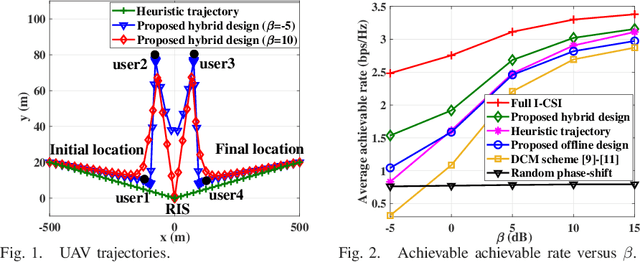
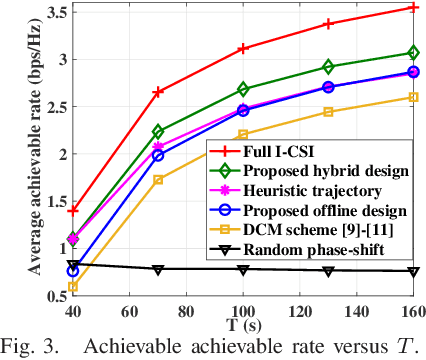
Abstract:This letter considers the reconfigurable intelligent surface (RIS)-aided unmanned aerial vehicle (UAV) communication systems in urban areas under the general Rician fading channel. A hybrid offline-online design is proposed to improve the system performance by leveraging both the statistical channel state information (S-CSI) and instantaneous channel state information (I-CSI). For the offline phase, we aim to maximize the expected average achievable rate based on the S-CSI by jointly optimizing the RIS's phase-shift and UAV trajectory. The formulated stochastic optimization problem is difficult to solve due to its non-convexity. To tackle this problem, we propose an efficient algorithm by leveraging the stochastic successive convex approximation (SSCA) techniques. For the online phase, the UAV adaptively adjusts the transmit beamforming and user scheduling according to the effective I-CSI. Numerical results verify that the proposed hybrid design performs better than various bechmark schemes, and also demonstrate a favorable trade-off between system performance and CSI overhead.
Energy-Efficient UAV-Mounted RIS Assisted Mobile Edge Computing
Mar 24, 2022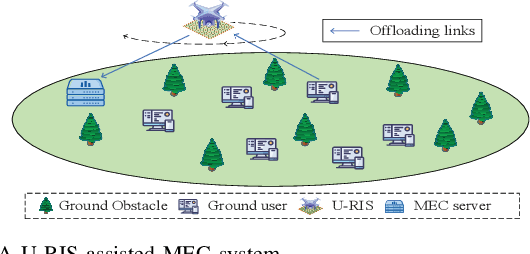

Abstract:Unmanned aerial vehicle (UAV) and reconfigurable intelligent surface (RIS) have been recently applied in the field of mobile edge computing (MEC) to improve the data exchange environment by proactively changing the wireless channels through maneuverable location deployment and intelligent signals reflection, respectively. Nevertheless, they may suffer from inherent limitations in practical scenarios. UAV-mounted RIS (U-RIS), as a promising integrated approach, can combine the advantages of UAV and RIS to break the limit. Inspired by this, we consider a novel U-RIS assisted MEC system, where a U-RIS is deployed to assist the communication between the ground users and an MEC server. The joint UAV trajectory, RIS passive beamforming and MEC resource allocation design is developed to maximize the energy efficiency (EE) of the system. To tackle the intractable non-convex problem, we divide it into two subproblems and solve them iteratively based on successive convex approximation (SCA) and the Dinkelbach method. Finally we obtain a high-performance suboptimal solution. Simulation results show that the proposed algorithm significantly improves the energy efficiency of the MEC system.
Energy-Efficient UAV Communications: A Generalised Propulsion Energy Consumption Model
Feb 17, 2022

Abstract:This paper proposes a generalised propulsion energy consumption model (PECM) for rotary-wing ummanned aerial vehicles (UAVs) under the consideration of the practical thrust-to-weight ratio (TWR) with respect to the velocity, acceleration and direction change of the UAVs. To verify the effectiveness of the proposed PECM, we consider a UAV-enabled communication system, where a rotary-wing UAV serves multiple ground users as an aerial base station. We aim to maximize the energy efficiency (EE) of the UAV by jointly optimizing the user scheduling and UAV trajectory variables. However, the formulated problem is a non-convex fractional integer programming problem, which is challenging to obtain its optimal solution. To tackle this, we propose an efficient iterative algorithm by decomposing the original problem into two sub-problems to obtain a suboptimal solution based on the successive convex approximation technique. Simulation results show that the optimized UAV trajectory by applying the proposed PECM are smoother and the corresponding EE has significant improvement as compared to other benchmark schemes.
Elevation Angle-Dependent Trajectory Design for Aerial RIS-aided Communication
Sep 10, 2021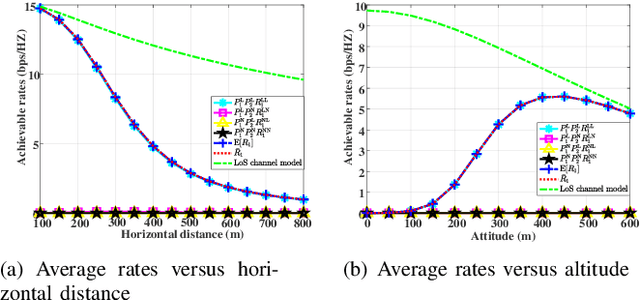
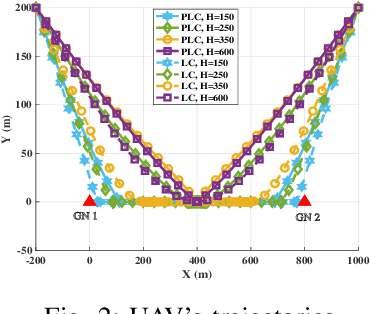
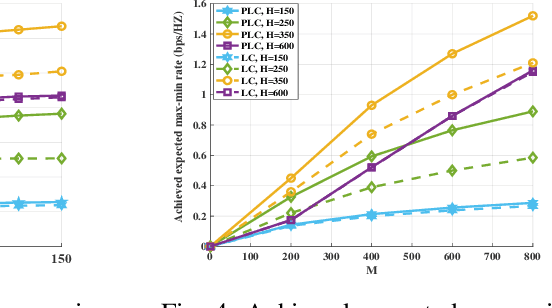
Abstract:This paper investigates an aerial reconfigurable intelligent surface (RIS)-aided communication system under the probabilistic line-of-sight (LoS) channel, where an unmanned aerial vehicle (UAV) equipped with an RIS is deployed to assist two ground nodes in their information exchange. An optimization problem with the objective of maximizing the minimum average achievable rate is formulated to design the communication scheduling, the RIS's phase, and the UAV trajectory. To solve such a non-convex problem, we propose an efficient iterative algorithm to obtain its suboptimal solution. Simulation results show that our proposed design significantly outperforms the existing schemes and provides new insights into the elevation angle and distance trade-off for the UAV-borne RIS communication system.
Full-Dimensional Rate Enhancement for UAV-Enabled Communications via Intelligent Omni-Surface
Jun 05, 2021


Abstract:This paper investigates the achievable rate maximization problem of a downlink unmanned aerial vehicle (UAV)-enabled communication system aided by an intelligent omni-surface (IOS). Different from the state-of-the-art reconfigurable intelligent surface (RIS) that only reflects incident signals, the IOS can simultaneously reflect and transmit the signals, thereby providing full-dimensional rate enhancement. To tackle such a problem, we formulate it by jointly optimizing the IOS's phase shift and the UAV trajectory. Although it is difficult to solve it optimally due to its non-convexity, we propose an efficient iterative algorithm to obtain a high-quality suboptimal solution. Simulation results show that the IOS-assisted UAV communications can achieve more significant improvement in achievable rates than other benchmark schemes.
 Add to Chrome
Add to Chrome Add to Firefox
Add to Firefox Add to Edge
Add to Edge